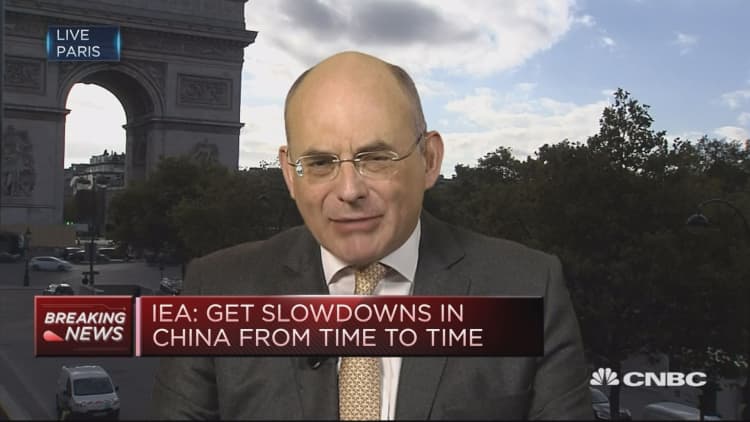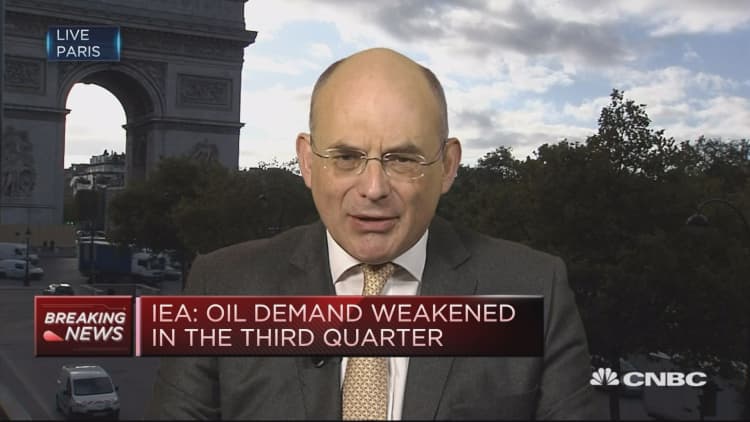
The global outlook for oil markets in 2018 could put a dampener on hopes for higher prices, according to the latest monthly report from the International Energy Agency (IEA).
Global stock builds, rising non-OPEC production and sluggish growth in demand could weigh on the oil price, the IEA said in its closely-watched report published Thursday.
Looking into oil supply and demand balances in 2018, the IEA said that it saw that "three quarters out of four will be roughly balanced — again using an assumption of unchanged OPEC production, and based on normal weather conditions."
"However, our current numbers for the first quarter of 2018 imply a stock build of up to 0.8 million barrels a day (mb/d). Taking 2018 as a whole, oil demand and non-OPEC production will grow by roughly the same volume and it is this current outlook that might act as the ceiling for aspirations of higher oil prices," it added.
"Leading oil producers will have looked at their market balances and probably drawn the same conclusion," it added.
The latest monthly report from the IEA comes amid optimistic comments from the major oil producer group OPEC that the global oil market is rebalancing following several years of low prices on the back of a glut in supply.
OPEC and non-OPEC oil producers, including Russia, agreed a historic deal last November to curb global oil output in a bid to support prices that have fallen from a lofty height of $114 a barrel in June 2014.
Neil Atkinson, head of the oil industry and markets division at the IEA, told CNBC on Thursday that this rebalancing was happening, slowly.
"But the main point is that it (the rebalancing) is happening more slowly than most of the producers who signed up to output cuts perhaps expected when they signed the agreement," he told CNBC Thursday.
"But it is happening, slowly and gradually. The surplus of oil stocks over a five-year average in the OECD (Organization for Economic Co-operation and Development countries) is gradually coming down so the trend is moving in the right direction from the producers' point of view."
He noted that 2018 could perhaps be "a little more challenging for them than they might have thought but the tendency in 2018 will be for a balanced market."
The deal is currently due to last until March 2018 although it is widely expected that OPEC and Russia will extend the deal with OPEC potentially announcing such a move when it meets at the end of November.
The IEA agreed, saying that "the next few weeks ahead of the producers' meeting in Vienna on November 30 will be crucial in shaping their decision on output. A lot has been achieved towards stabilizing the market, but to build on this success in 2018 will require continued discipline."
Global oil demand growth

Though prices have recovered from lows around the mid $20s seen in early 2016 they are still a long-way off previous levels; benchmark Brent crude is currently trading at $56.62 a barrel while West Texas Intermediate is fetching $50.97 a barrel.
The IEA noted that compliance with supply cuts within OPEC was 86 percent, year-to-date. It noted that in September, OPEC crude output had seen slightly higher flows from Libya and Iraq offset by lower supply from Venezuela. Overall, OPEC output in September was 32.65 mb/d, down from 400,000 barrels a day a year ago.
The IEA said it was keeping its forecasts from last month unchanged. Its estimate is for global demand growth of 1.6 million barrels a day (mb/d) in 2017 and 1.4 mb/d in 2018.
Following what it called "very strong year-on-year growth" in the second quarter of 2017, the IEA noted that the pace of growth had slowed into the third quarter, "reflecting relatively weak July and August data and the impact of hurricanes in September."
Meanwhile, the IEA said that global oil supply rose 90,000 barrels a day in September to 97.5 mb/d "as non-OPEC output edged higher" with U.S. shale oil producers in that group. For 2017, non-OPEC supplies of oil are expected to grow by 0.7 mb/d, followed by a 1.5 mb/d increase in 2018.


